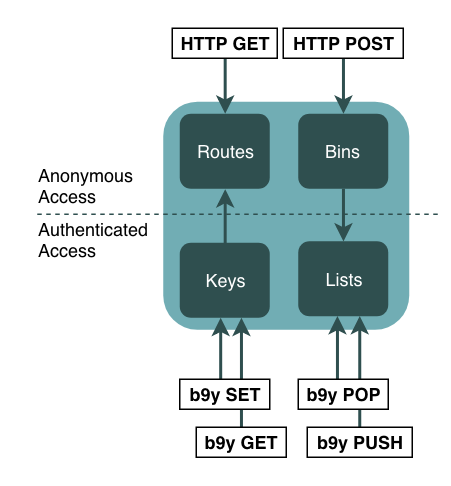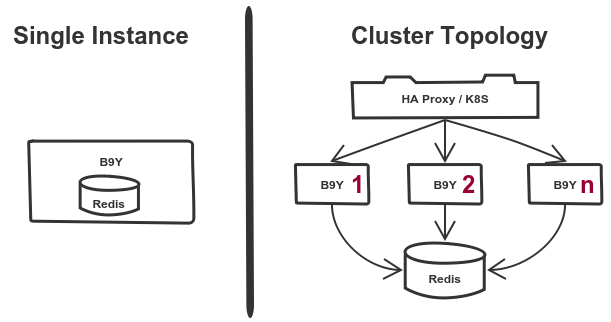New to Bambleweeny? This Getting Started Guide shows you how to run it and do your first set of data operations.
There are multiple ways of interacting with Bambleweeny. Whichever way you choose, all of them will use the REST API with OAuth and JSON over HTTP for communication. This makes it very easy to allow devices, apps and users inside and outside your firewall to access it.
All functionality is available over the REST API. It's an API first world! The /swagger endpoint gives you the Swagger file.
Perform commonly used operations in the command-line interface, available as binaries for Windows, MacOS and Linux.
For example, entering b9y-cli.exe -h http://10.158.27.88:8080 on a Windows machine connects you to Bambleweeny on a remote server using the default (admin) credentials.
The b9y library allows you to make Bambleweeny requests in Python.
pip install b9y
The command-line interface makes use of it, so you could look at the code as an example.
Are you a .NET or JavaScript developer? We'd love your contribution to write a client library for those languages.
The following SDKs are auto-generated from the Swagger file:
Python | Java | Ruby | PHP | JavaScript | Android | HTML
Bambleweeny gives you keys, lists, routes and bins. We'll cover all of these in the following section.
Unless exposed via routes (more on those below), all data is private to the respective individual users. Think of users rather like keyspaces.
The admin user (default credentials: admin/changeme) can create users, set quotas and get access to diagnostic information. Of course, the admin user has its own keyspace, too.
Create a user in the CLI:
create_user user1 secret
Users have their individual keyspace and can, by default, create an unlimited number of resources.
Resources and general access to Bambleweeny are protected by an OAuth server. Before making requests and data operations, users must get a token using the /auth/token endpoint and provide as an Authorization: Bearer HTTP header in the subsequent requests. Tokens expire after 3000 seconds (default configuration).
Starting the command-line interface without parameters will attempt a connection on localhost:8080 using the default admin credentials. Parameters -h for hostname, -u for username and -p for the password can be specified to use those instead. The command token in the command-line interface will print the token to STDOUT for your convenience.
Passwords are stored as hash inside Redis using a default 'salt' – you should set an environment variable with a custom value (see below), otherwise session hijacking is possible.
Keys represent the essential data type in Bambleweeny as a key-value store. Valid key names are e.g. foo, my_key788, and system:debug:level.
In the CLI you can issue set foo bar to create a key called foo with the value bar, or set foo 'hello, world!' for values that include spaces. Do this for simple content only, and use the REST API in Postman or from your application to add complex or UTF-8 encoded data.
Bambleweeny can handle binary content as well (however, the payload size is currently limited to 50kb):
curl --upload-file image.png http://b9y/keys/pic -H AUTH
To read the key you can use get key or make the following (authenticated) HTTP request:
curl http://<host>:<port>/keys/foo -H 'Authorization: Bearer <token>
incr mykey increases a numeric key by 1 and returns it. If the key does not exist, it will be created and the operation returns 1.
Routes allow users to 'expose' keys and make them publicly available without the need for authentication. This is very useful if you want Bambleweeny to act as a web cache, mock API endpoints or simply share specific pieces of data within your distributed systems.
Using the CLI, the following set of commands create a key, exposes it over HTTP with the content type application/json and returns the newly created endpoint:
set api '{"message": "hello"}'
route api 'application/json;charset=utf-8'
/routes/125e6a6f-c3f3-403b-b096-89978773139b
curl -i http://<host>:<port>/routes/125e6a6f-c3f3-403b-b096-89978773139b
Content-Type: text/html {"message": "hello"}
Nested keys give you greater flexibility to produce dynamic content. You can reference a key as !@[mykey] inside the value of another key. Let's make the previous example more interesting:
set api '{"message": "!@[message]"}'
set message 'cool stuff!'
route api 'application/json;charset=utf-8'
Routes are parsed dynamically, so the cURL command will return
{"message": "cool stuff!"}
Lists can store multiple values in one key, you use a push command to add an item and pop to retrieve an item. Retrieving an item also removes it from the list:
push mylist cat
push mylist dog
pop mylist
cat.
pop mylist
dog
pop mylist
None
Lists can be used to implement messaging queues. Reading from the queue removes the message. A future version might see a mechanism to properly dequeue it.
Bins are endpoints that allow non-authenticated access to POST data, which is added to a list. You can use this mechanism to create event logs, webhooks, or collect form data.
Using the CLI, the following command creates a bin, exposes it over HTTP and returns the newly created endpoint:
bin my_list
/bins/125e6a6f-c3f3-403b-b096-89978773139b
Anybody who knows the endpoint URL of the bin can post data to it:
echo hello | curl -X POST -d@- http://<host>:<port>/bins/125e6a6f-c3f3-403b-b096-89978773139b
The owner of the bin can then use pop commands to retrieve an element:
pop my_list
docker run -d -p 8080:8080 u1ih/bambleweeny
This gives you a single, stateful and self-contained instance. Good enough for demos and tests.
Want to run it on a Raspberry Pi?
docker run -d -p 8080:8080 u1ih/bambleweeny:arm-latest
Image on DockerHub | Dockerfile
Bambleweeny uses Redis as an in-memory database. See below how to configure an external Redis connection using environment variables.
How about running this as a topology instead, with one Redis container and one (and then later more) instances of b9y? Assuming you have Docker and docker-compose installed, simply run this command:
curl -sSL http://bit.ly/run-bambleweeny | sh
You can modify the docker-compose.yml file to your needs.
Deploy a single instance of Bambleweeny on OpenShift:
-
Deployment
oc new-app u1ih/bambleweeny -
Expose
oc expose svc/bambleweeny
-
Deployment
kubectl run b9y --image=u1ih/bambleweeny:latest --env="redis_host=172.17.0.1" --env "redis_port=6379" --port=8080 -
Create a Service
kubectl expose deployment b9y --type=NodePort -
Scale up to 5 replicas
kubectl scale deployments/b9y --replicas=5 -
Show the endpoint
kubectl get services | grep b9y
There are several ways to configure Bambleweeny and modify the default settings.
By default, b9y rund in 'Lite' mode which essentially starts an embedded Redis engine inside the container. This is good enough for many use cases, but you may want to point it to a 'proper' Redis environment instead. You can do this by setting environment variables:
docker run [...] -e redis_host=localhost -e redis_port=6379 u1ih/bambleweeny:latest
If you run b9y in a public environment you should provide an environment variable salt to increase the security and avoid potential session hijacking:
docker run [...] -e salt=MYSECRET u1ih/bambleweeny:latest
Provide an environment variable token_expiry that overrides the default token expiry of 3000 seconds:
docker run [...] -e token_expiry=999999999 u1ih/bambleweeny:latest
The authenticated admin user can trigger the following endpoints:
Provides detailed information on the Redis connection
Triggers a 'save' on the Redis side, which dumps the content of the in-memory database to disk. You can map the directory to your host (and persist the data) by running b9y the following way:
docker run [...] -v data:/data u1ih/bambleweeny:latest
The following settings are currently not configurable:
Messages cannot be larger than 50kb (set in server.py CherryPy config)
Limit currently at 256 MB
Set to /data


